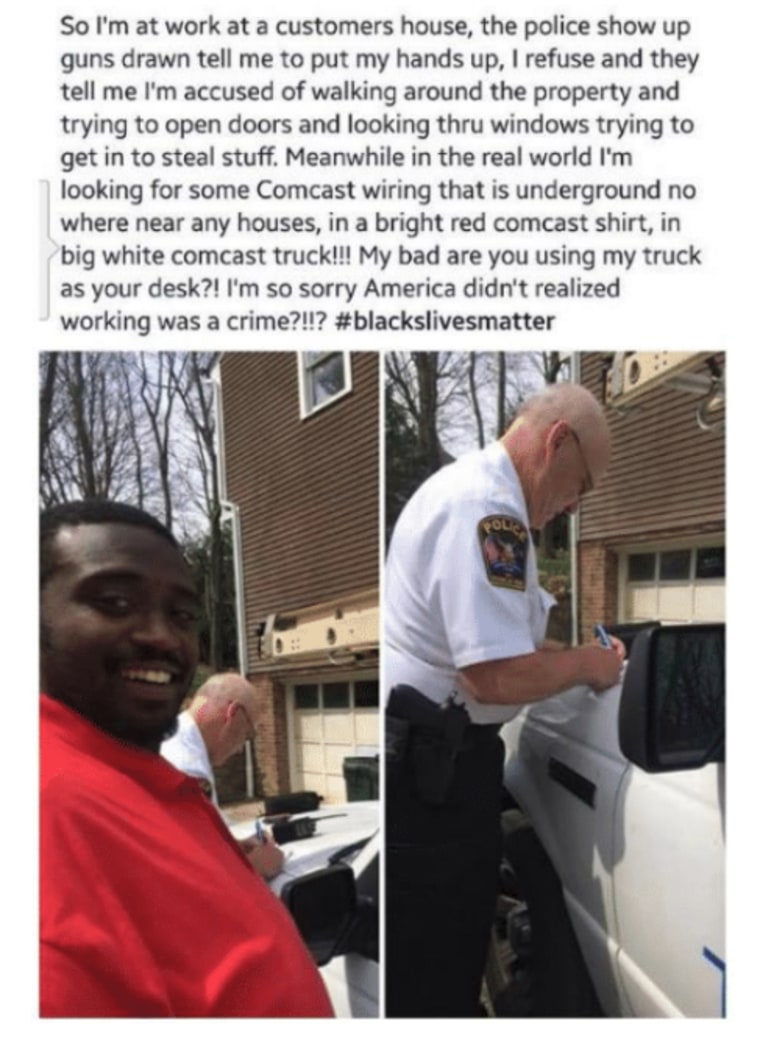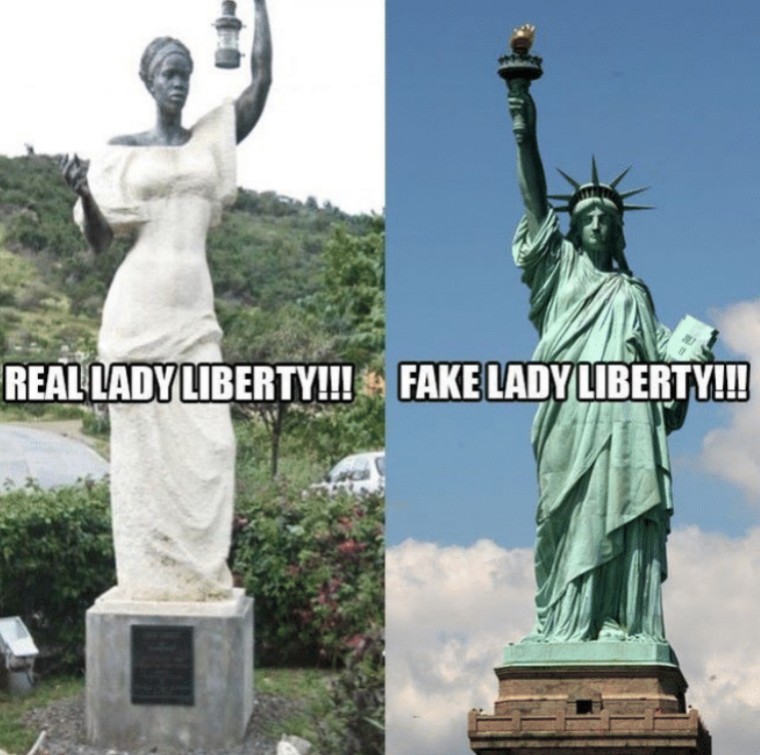The tweet ranked among the top performers of Russia’s U.S. election interference operation. Let’s call it outraged working guy.
It features an image of a black man with a uniformed white police officer writing something in the background. The text above the images describes an encounter that began after someone called the police on the black man, a cable worker, while he was on a job.
Then comes the kicker: “I’m so sorry America didn’t realized [sic] working was a crime?!!? #blacklivesmatter.” That tweet, dispatched on Oct 10, 2016, by @Crystal1Johnson, racked up 91,029 favorites and retweets, over 50,000 upvotes on Reddit and at least one news story, according to reports produced by two independent groups for the Senate Intelligence Committee and released Monday.
@Crystal1Johson ramped up the outrage with her own commentary on the images, which appeared to have been screengrabbed from a Facebook post: “When It’s slowly becoming illegal for black people to work #BlackTwitter.” But @Crystal1Johnson was actually an account controlled by a Kremlin-linked company in St. Petersburg known as the Internet Research Agency (IRA), which was trying to spread and exploit racial divisions ahead of the election.

Outraged working guy, experts say, illuminates Russia’s sophisticated understanding of the way that centuries of discrimination in everything from education to health care, jobs to housing — along with potentially dangerous encounters with police like outraged working guy — shapes black American life. It’s an understanding that many white Americans lack, or won’t acknowledge.
And it’s an example of the kinds of messages Russia used both before and after the election to attract followers, or prompt likes, retweets and shares from accounts intelligence operatives controlled and then used to disrupt faith in American democratic processes and institutions.
That gap in understanding and experience — which creates a strong affinity within groups, and stokes strong divisions between them — poses a national security risk at least as significant as the vulnerabilities of the social media platforms Russia used to influence the 2016 election, five experts in Russian intelligence, history and American civil rights told NBC News. The danger comes in the messages about voting and candidates that Russia slipped in, once seemingly unrelated posts had built a sense of community and trust.
“This is our Achilles’ heel, racial division, and the stories we tell to cover them up,” said Glenda Gilmore, a professor of history at Yale whose books on American political history and civil rights took her inside Soviet archives. “The Russians certainly know it, even if we don’t.”
The new reports for the Senate Intelligence Committee underscore the Russian use of tools provided by social media platforms, including Facebook and Twitter, to target content to particular groups of people. Social media companies have previously said Russia’s disinformation efforts reached about half of the American population. The reports show the extent of Russia’s focus on influencing black Americans.

To make the online posts appealing — and ultimately to get them picked up in the media and shared by well-known public figures — the Russian operatives expertly tapped into difficult, often-ignored elements of black life in America, said Renée DiResta, director of research at New Knowledge, a research organization that produced one of the two Senate reports.
Russian-controlled accounts like the one that dispatched outraged working guy — an account since removed — built a sense of outsider group camaraderie and righteous indignation, while also occasionally dispatching messages questioning the 2016 election’s relevance to black Americans or encouraging black Americans to cast a ballot for Green Party nominee Jill Stein. (That indirectly helped the Trump campaign, which was the apparent goal of the Russians.)
Other posts raised doubts about Democratic presidential nominee Hillary Clinton's interest in black people and shared false information about voting by text on Election Day.
The Russian operation was so sophisticated and well-timed that when news of another police shooting of an unarmed young black man filled headlines, messages describing black life as devalued went to groups that social media tools allow advertisers to identify as likely black and Baptist, DiResta said. That’s a group that’s traditionally more conservative.
The same images with a message slamming police for operating above the law went to black Americans who had previously liked or shared messages related to liberation theology, a more progressive religious tradition.
“What they did requires intricate knowledge of African-American life,” DiResta said, noting that she had to do research to understand some of the references. (DiResta is white.)
From almost the beginning of the Soviet Union, Russian intelligence operatives read American publications voraciously and studied racial inequality, segregation, lynchings, voting bans and working conditions for poor black and white Americans, Gilmore said. Initially, that interest was rooted in the desire to foment Communist revolution and unite workers around the world.
Throughout the 20th century, Russian intelligence operatives traveled in the southern United States, Gilmore said. At one point, the Kremlin maintained a “Negro Division” charged with developing expertise in how American racial discrimination worked, the effects of oppression on the oppressed and oppressors and how race was used by corporations and their wealthy owners, political figures and parties to pit poor white Americans against black ones.
Later, when the Soviet commitment to equality gave way to brutal, authoritarian regimes, highlighting racial inequality in the U.S. remained a way to embarrass America and curtail its standing and influence in the world.
“What’s clear now, after 2016, is that information has survived,” Gilmore said. “It has clearly been well maintained and fed, then passed along into the modern intelligence age.”
When DiResta presented an early draft of her findings to the Senate panel, she said, most of the senators grasped the fact that black Americans had been targeted. But it was Sen. Kamala Harris, D-Calif., who prompted discussion about the racial messaging contained in much of the material sent to other targeted groups, such as supporters of state secession and unbridled gun rights.
While the effect of Russian targeting on African Americans is unclear, many experts have noted that black voter participation fell in 2016 for the first time in two decades while participation by other groups expanded. The change has also been attributed to voter suppression efforts, reduced time frames for early voting in some states and new voting restrictions allowed to stand after the Supreme Court’s 2013 decision to eliminate certain voting rights protections.
“Two things are really clear to me,” said Rashad Robinson, executive director of Color of Change, an internet-based civil rights organization that has pushed Facebook to examine its algorithms and was reportedly investigated by a Facebook-hired public relations firm. “The first is how much better the Russians understand black people than Facebook, the Democratic Party or many other Americans do.“
The other: how ill-equipped Facebook and other tech companies remain to recognize and responsibly manage their impact on human lives and American democracy, Robinson said.
Facebook’s algorithms have, among other things, allowed advertisers to target groups in ways that are too closely aligned with race and ethnicity, making it possible for companies to sometimes skirt civil rights law, Robinson said.
When the NAACP announced Monday that it would call on its members to boycott Facebook, Facebook shared updates on the status of a civil rights audit demanded by Color of Change and other groups in a series of more than 20 meetings with the social media company.
The information released indicates that Facebook has plans to combat voter suppression on the platform and added a way for users to report incorrect voter information. The company also said it removed “thousands” of potentially discriminatory ad targeting terms.
In national security circles, discussion has focused on the mechanical elements of Russia’s disinformation tactics, as well as Russia’s persistent interest in undermining Western democracies, said Spencer Boyer, director of the Washington office of the Brennan Center for Justice at the New York University School of Law. But Boyer believes intelligence experts must also understand the reasons America was so vulnerable.
“Our long racial struggles in this country remain a major gulf,” said Boyer, who served as the senior Europe analyst with the National Intelligence Council, a think tank for the U.S. intelligence community. “The lack of trust that African Americans have in law enforcement and other security-focused organizations is based on real experiences. We have to be willing to talk about that, do the work to eliminate that opening for Russia or any other nation-state which may attempt the same thing.”
That work is necessary to develop “better defenses,” Boyer said. It needs to include corporations and people with national security expertise, advanced technical skills and an understanding of human psychology as well as inequality, distrust and division in the U.S., Boyer said.
“That has to be the approach,” Boyer said. “We clearly need to study the demand side of the disinformation narrative, not just the supply side.”
